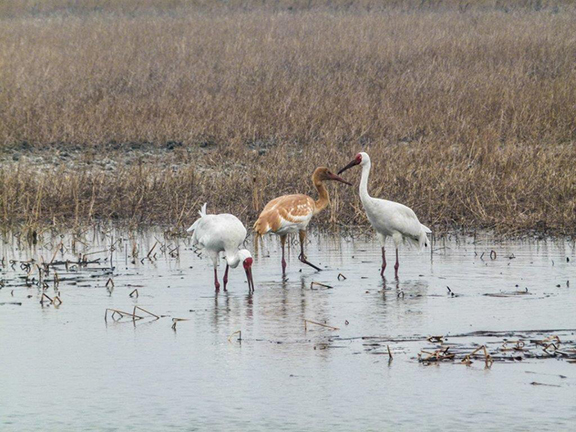
Photo by Crawford Prentice
Media Contact: Kate Fitzwilliams, Marketing/PR Specialist, (608) 356-9462 ext. 147
Baraboo, WI – The Ramsar Convention, an international treaty for the conservation and wise use of wetlands, reviews and designates key sites nominated by national governments as Wetlands of International Importance. This week, Jilin Momoge National Nature Reserve, where an astounding 97% of the world’s Siberian Cranes stage on migration, was one of five new sites formally recognized as a Wetland of International Importance in the People’s Republic of China.
“Momoge is one of the key sites where the International Crane Foundation (ICF) works with Chinese colleagues and local communities to develop innovative methods for water management, wetland restoration, and waterbird monitoring in response to development pressures and climate change,” ICF Senior Director, Conservation Networking, Claire Mirande said. “The Ramsar designation is acknowledgement of the conservation efforts of Momoge National Nature Reserve over the last decade. This effort began under our UNEP/GEF Siberian Crane Wetland Project, and it is very rewarding to see it come to fruition.”
Other Ramsar sites important to cranes include Horicon National Wildlife Refuge in Wisconsin (release site for the Whooping Crane reintroduction), Zhalong and Poyang Lake Nature Reserves in China, the Zambezi Delta and Kafue Flats in Africa, and many more!
From the Ramsar Forum Announcment:
Jilin Momoge National Nature Reserve (144,000 ha; 45°54’32”N 123°45’56″E) located in the transition zone between deserts and grasslands in the northwestern part of Jilin Province, supports wetland types that are representative of the biogeographic region, such as low plain wetlands, rivers, temperate meadow and shallow lakes. These habitats provide important refuge for a variety of fish and bird species. In spring 2012, 97% of the world’s population of the critically endangered Siberian Crane (Leucogeranus leucogeranus) were recorded at the site, and over 100,000 waterbirds were recorded in each year between 2010 and 2012. The site plays an important role in groundwater recharge, flood water storage, and local climate regulation. It is also important in supporting the local fisheries, livestock farming and agriculture.
ICF works worldwide to conserve cranes and the ecosystems, watersheds, and flyways on which they depend. ICF provides knowledge, leadership, and inspiration to engage people in resolving threats to cranes and their diverse landscapes. The success of ICF is possible solely through the generous support of our members and donors. For more information about ICF visit www.savingcranes.org. For more information about The Ramsar Convention on Wetlands visit http://www.ramsar.org
